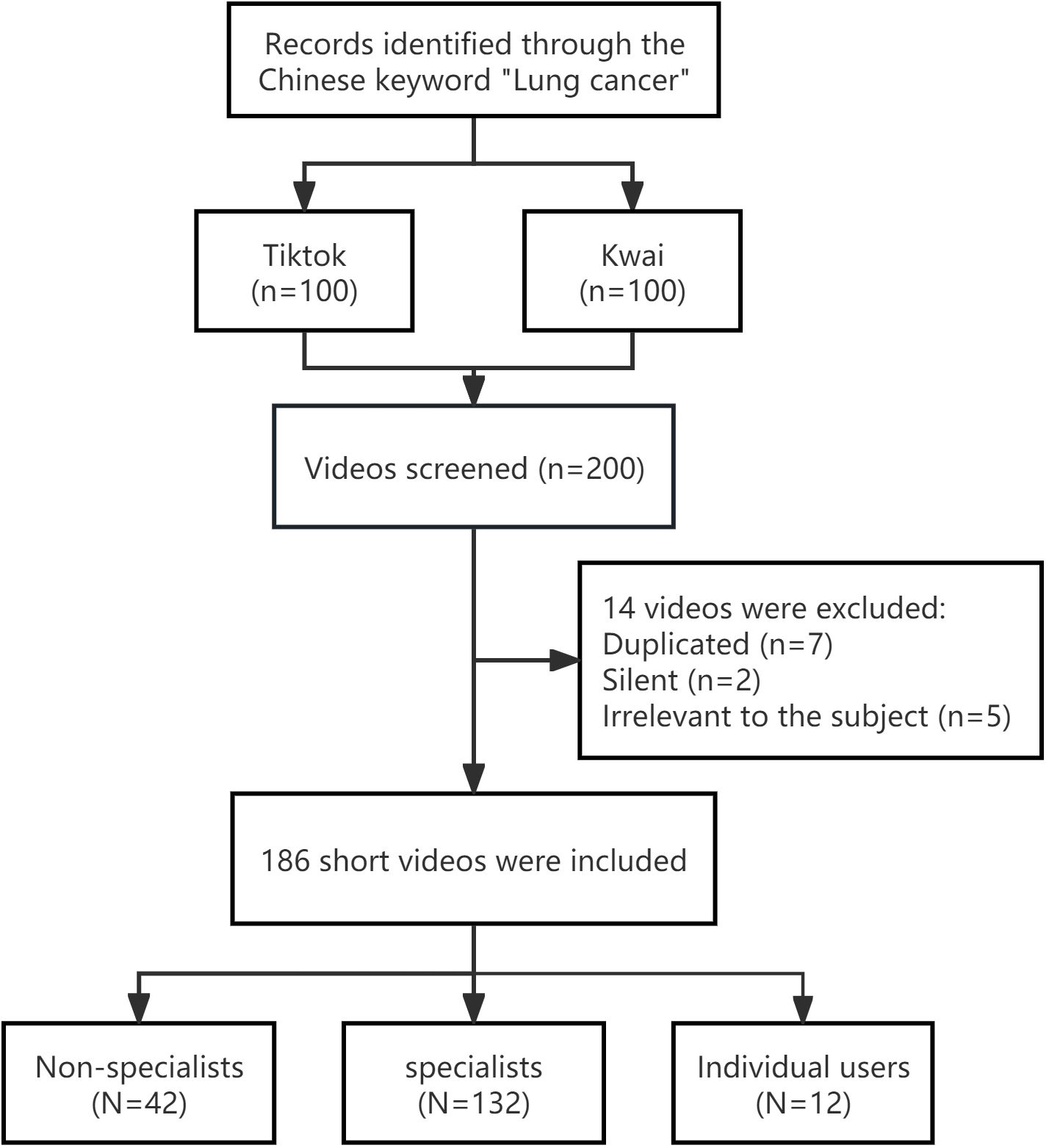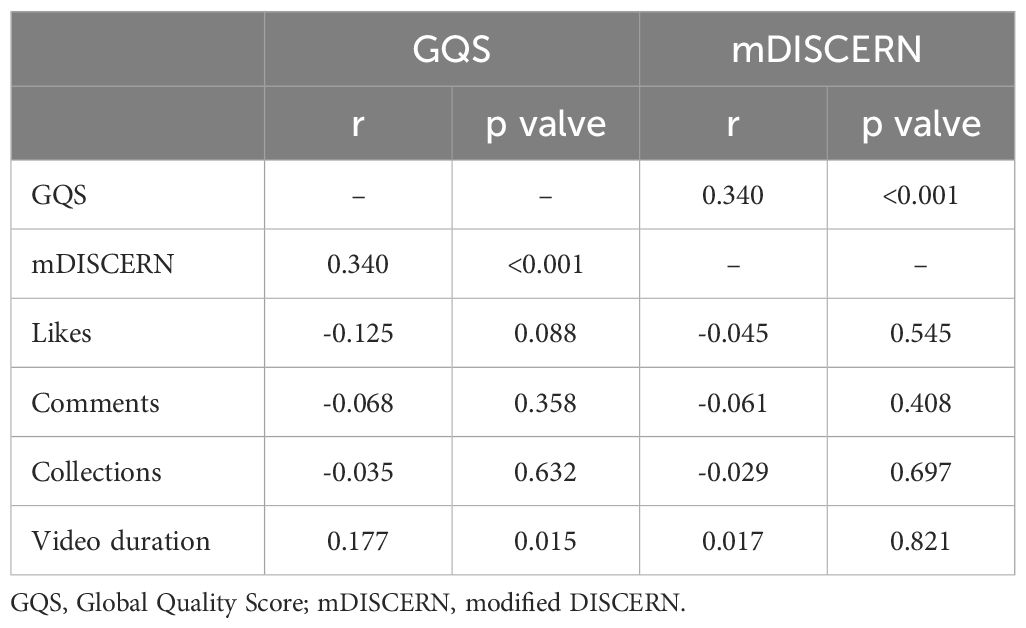- Department of Respiratory, Liyang People’s Hospital of Jiangsu Province, Liyang, China
Background: The morbidity and mortality rates of lung cancer continue to rise, leading to a significant disease burden. Health education on lung cancer serves as an effective approach for prevention and treatment. With the increasing popularity of the Internet, an escalating number of patients are turning to video platforms for health information. Short videos facilitate better absorption and retention of information, thus becoming the primary channel for health education communication. However, the quality of information provided in videos on these platforms remains uncertain. Therefore, this study aims to assess the information quality pertaining to lung cancer in short videos available on a Chinese video platform.
Methods: Lung cancer-related videos on two short video platforms (TikTok and Kwai) were screened, and only Chinese (Mandarin) videos were included. The Global Quality Score (GQS) and modified DISCERN (mDISCERN) tools were then used to evaluate the quality and reliability of the information. A comparative analysis was conducted on videos from various sources. Additionally, correlation analysis was employed to investigate the factors influencing video quality.
Results: After screening, a total of 186 videos were included. The median GQS score and mDISCERN score were 3 (IQR: 3-4) and 2 (IQR: 2-4), respectively. A total of 44.1% of the lung cancer videos provided a comprehensive explanation of the symptoms, while only 3.2% fully explanation the complications associated with lung cancer. Health professionals, particularly specialists, demonstrated higher quality video information compared to individual users (P<0.001). The correlation coefficient between GQS score and mDISCERN score was 0.340, showing a significant positive correlation (P<0.001). In addition, GQS score was positively correlated with video duration (r=0.177, P=0.015)
Conclusion: The information quality of the 186 videos screened by the two platforms in this study was generally unsatisfactory. However, videos provided by experts were deemed relatively reliable, with video duration being closely associated with information quality. Therefore, it is crucial to meticulously screen high-quality and dependable videos on the platform in order to effectively guide lung cancer prevention and treatment.
Introduction
The prevalence of lung cancer, a highly aggressive disease, exerts a significant impact on the escalating burden of cancer-related mortality worldwide (1–3). In 2020 alone, there were 2.2 million newly diagnosed cases and 1.8 million reported deaths attributed to this condition (1). The latest epidemiological studies conducted in Europe indicate that lung cancer accounts for 20% of all deaths in the region, with a persistently increasing mortality rate observed among the elderly population (2). The trend of cancer burden in China from 2005 to 2020 revealed that trachea, bronchus, and lung cancer had the highest mortality rate among males, reaching 75.5 per 100,000 (3). The incidence and mortality rates of lung cancer exhibit significant variations across different regions worldwide, with countries characterized by higher levels of economic development, as measured by the Human Development Index (HDI), experiencing three to four times greater incidence and mortality rates (1, 4). These variations can be attributed to factors such as tobacco consumption patterns, gender disparities, and divergent economic trends (5).
The mortality rate of lung cancer in developed countries has witnessed a decline in recent years, primarily attributed to the implementation of tobacco control measures, enhanced screening programs, and improved treatment options (1). In low- and middle-income countries, there exist both patient-related barriers and obstacles within national healthcare systems (4). Apart from limited accessibility to state-of-the-art therapies for lung cancer, primary healthcare professionals lack sufficient knowledge regarding the latest screening guidelines (6). Lung cancer screening guidelines mainly use low-dose-computed-tomography (LDCT), followed by bronchoscopy and sputum screening. The latest screening protocols include artificial intelligence-assisted CT examination and liquid biopsy (7). Patients themselves may also exhibit inadequate awareness about lung cancer, a lack of understanding regarding the benefits of early screening, and possess fatalistic views towards this disease (8, 9). Therefore, a comprehensive understanding of the etiology of lung cancer, early screening methods, and standardized treatment can significantly enhance patients’ survival rates.
The reform of information technology is impacting people’s daily life in various ways. It also offers patients effective health communication methods, enabling them to access relevant disease management information and empowering them with disease management capabilities (10). Visual information platforms, such as TikTok and Kwai, offer more visually appealing image and video content that facilitates patients’ comprehension and retention of information. Several studies (11–14) have examined health-related information available on these platforms, including chronic obstructive pulmonary disease (COPD), inflammatory bowel disease (IBD), and cancer. These studies have found that patients are more inclined to accept and remember visually engaging relevant information (15, 16). In addition, there is evidence (17, 18) that active use of the visual information platform is associated with a good prognosis of patients, the platform helps patients with self-disease management, and reduces the psychological burden of patients. However, short video platforms can lead to the rapid spread of false health-related information, which can mislead patients’ disease management decisions and even pose a threat to their lives. Health information on the Internet is often complex and challenging for non-professionals to comprehend, especially for individuals with limited health literacy. A study (19) revealed that over half of COPD patients encountered difficulties in discerning between high- and low-quality health information online. Therefore, it is crucial to assess the credibility of image-based information platforms and guide lung cancer patients towards standardized disease management protocols in order to reduce lung cancer mortality rates.
Previous studies have evaluated the quality of health information of several diseases on TikTok (20–22), but the quality of lung cancer short video information is still unclear. In order to improve the information content of lung cancer short video and guide the disease management of lung cancer patients, this study will examine the quality of lung cancer information on domestic short video platforms and evaluate the quality of lung cancer related health information.
Methods
Data collection
Between April 6, 2024 and April 7, 2024, we conducted a cross-sectional study. In this study, the Chinese keyword “lung cancer” was used to search for related videos on the two most popular short video sharing platforms in China (TikTok and Kwai), and the default top 100 videos were screened. Videos that met the following criteria were excluded from the analysis: 1) repetitive videos; 2) silent videos and 3) videos that were unrelated to the topic. The video was screened by two respiratory doctors (Xinyu Zhao and Xinyi Yao), and the content and quality of the video were independently reviewed. The data were recorded in Excel (Microsoft Corporation) and it was agreed that a third senior respiratory specialist (Binbin Sui) would conduct a negotiated assessment of the disputed issues. The following video information was collected: the platform of videos, the source of videos, the identity authentication of the publisher, date of publication, departments of the medical worker, duration of videos, the number of likes, comments and collections, the content and the quality of the videos. The data of this study are publicly available and no ethical statement is required.
Assessment of video information’s quality and reliability
All searches were conducted on a public computer, all Settings and history on the computer were deleted before the search is conducted, and cookies were disabled during the search process to avoid affecting the data. The Global Quality Score (GQS) and the modified DISCERN (mDISCERN) tool were utilized for assessing the information quality and reliability of videos, respectively. The GQS is a widely used video scoring tool to assess the informational quality of a video and consists mainly of five criteria ranging from 1 (poor quality) to 5 (high quality), with higher scores indicating higher quality, as detailed in Supplementary Table 1 (23, 24). The reliability of health-related content was evaluated using the mDISCERN tool (11, 25). The instrument consists of five questions (Supplementary Table 2) that are scored on the basis of a “yes” or “no” response, with a minimum score of 0 and a maximum score of 5. At the same time, we also assessed the video content and employed an additional scoring tool to evaluate seven key aspects of lung cancer videos, encompassing epidemiology, etiology, symptoms, diagnosis, treatment, prevention, and complications. The scoring system was categorized into three levels: no inclusion (0 points), partial elucidation (1 point), and full explanation (2 points). Specialists include doctors in respiratory, thoracic surgery and oncology, while non-specialists mainly include doctors in other departments such as dermatology and gastroenterology.
Statistical analysis
Continuous variables were expressed as mean ± standard deviation (SD) or median and interquartile range (IQR) depending on whether they followed a normal distribution, and the Student’s t test or Mann-Whitney U test was used to analyze the data. Categorical variables were presented in frequency and percentage, and Chi-square tests or Fisher exact tests were used. The Pearson correlation coefficient was calculated to evaluate the correlation between different scores and video features. Cohen’s kappa coefficient was used to assess the consistency of the scores of two independent reviewers. Statistical analysis and plotting were performed using SPSS version 26.0 (IBM; Chicago, IL, USA) and R statistical software version 4.3.1 (www.r-project.org). P value < 0.05 was considered to indicate statistical significance.
Results
Short video features
The video platforms TikTok and Kwai are widely regarded as the two most famous platforms in China. After carefully screening the top 100 comprehensive video messages on two platforms, we eliminated duplicate, silent, and irrelevant content, and ultimately selected 186 short video messages (Figure 1). We have classified the sources of videos into three categories: specialists, non-specialists and individual users. Out of these videos, 71% were uploaded by professionals, 22.6% by non-professionals, and 6.4% by individual users. The median video duration was 72 seconds (Interquartile range [IQR]:21-101), the median number of likes and collections was 633(IQR:173-4010) and 132(IQR:28-636), respectively, and the median number of comments received was 58(IQR:13-343). The median completeness score was 6(IQR:5-8), the median GQS was 3(IQR:3-4), and the median mDISCERN score was 2(IQR:2-4) (Table 1). The quality assessment revealed that the lung cancer video information on the platform exhibited a low level of quality.
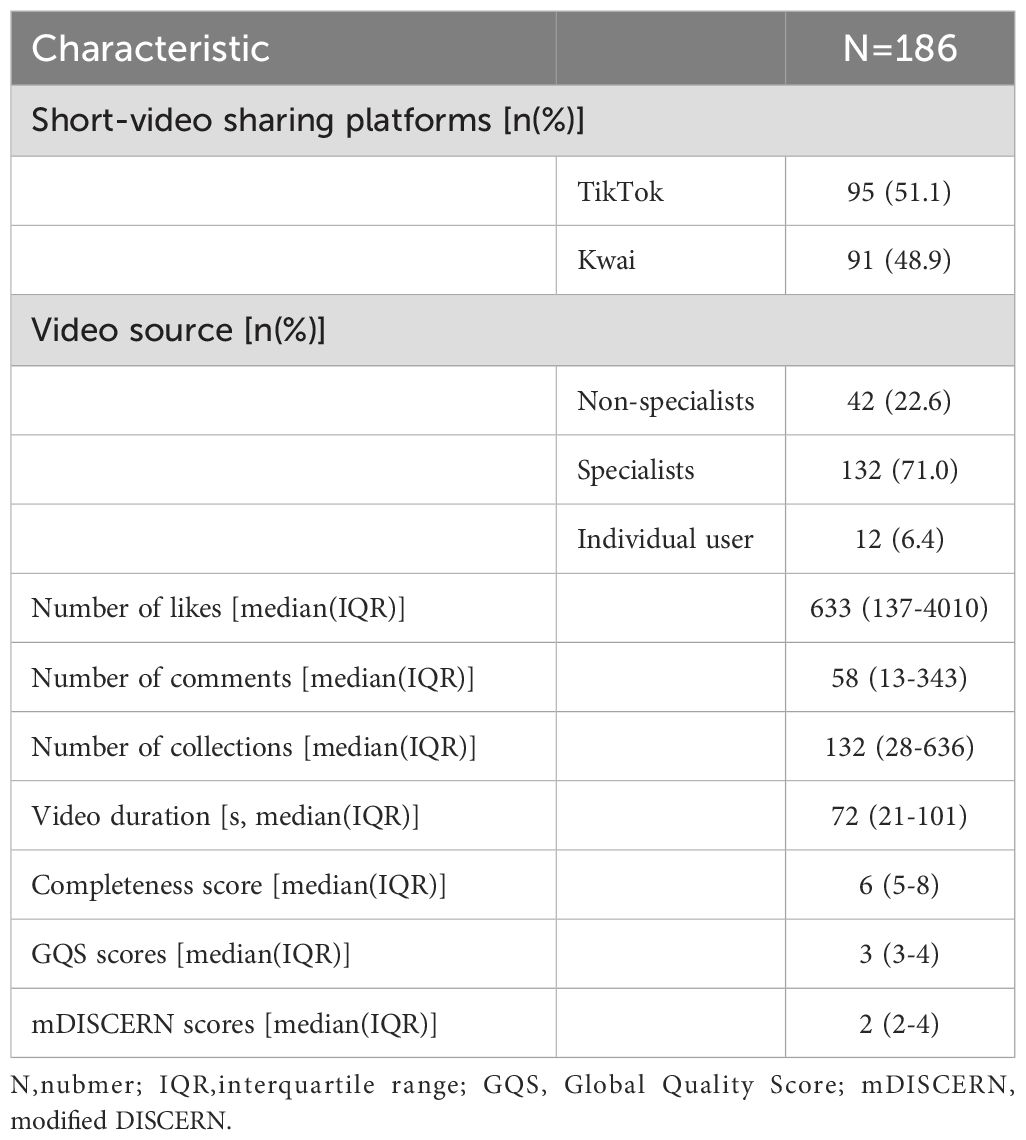
Table 1. Characteristics of 186 lung cancer related-short videos on TikTok and Kwai in China in 2024.
Short video content
We classified the completeness of the video content into seven aspects, encompassing epidemiology, etiology, symptoms, diagnosis, treatment, prevention, and complications associated with lung cancer. As shown in Figure 2, most of the videos comprehensively described the typical symptoms associated with lung cancer (44.1%), however, only a few videos introduced the complications of lung cancer (3.2%). Moreover, only a subset of the video full explanation the remaining 5 aspects of lung cancer. Among them, a mere 5.4% of the videos provide an in-depth explanation of the epidemiology of lung cancer, while 22.5%, 38.7%, and 12.7% of the videos respectively delve into the etiology, diagnosis, and treatment of this disease. (Table 2).
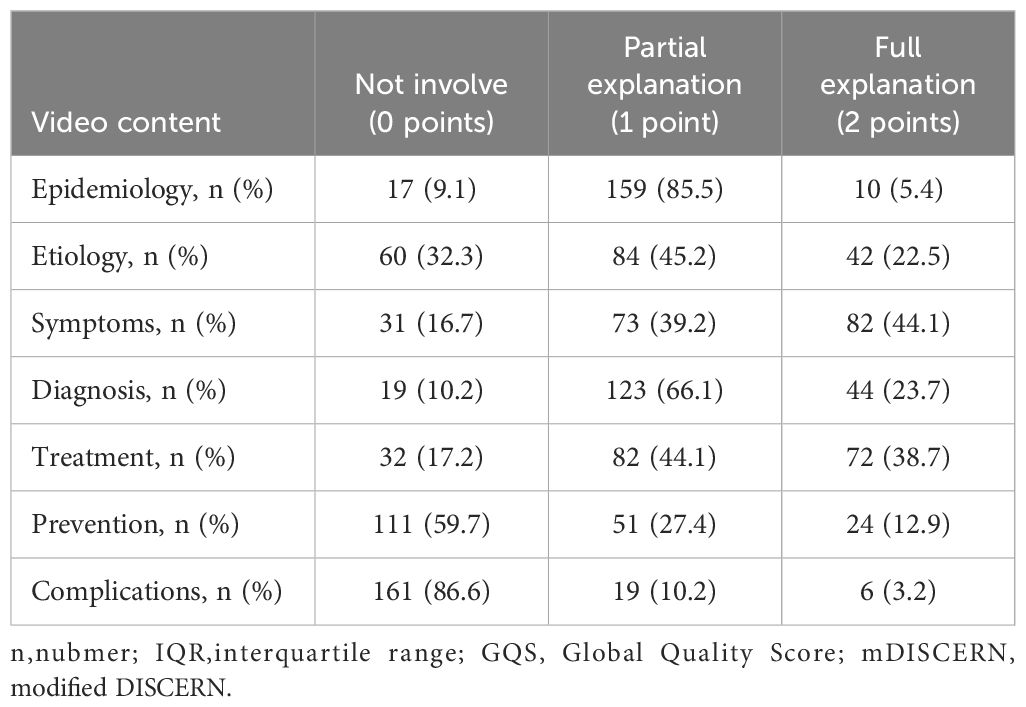
Table 2. Completeness of 186 lung cancer related-short videos content on TikTok and Kwai in China in 2024.
Short video source analysis
In addition, we conducted a comparative analysis of the videos on both platforms and observed that TikTok exhibited significantly higher engagement metrics in terms of likes (median: 1706 vs 209, P<0.001), comments (median: 173 vs 29, P<0.001), and collections (median: 290 vs 49, P<0.001) compared to Kwai. Conversely, Kwai demonstrated superior video completeness when compared to TikTok. However, both platforms displayed similar scores in terms of video quality (mDISCERN scores, median:2 vs 2, P=0.131) (Table 3). We conducted a further analysis of videos from various sources and observed that the quality of video information shared by healthcare professionals surpassed that posted by individual users. Notably, specialists exhibited significantly higher quality scores compared to non-specialists (mDISCERN scores, median: 3 vs 2, P<0.001) (Table 4). The Cohen’s kappa values for GQS and the mDISCERN were 0.921 and 0.893, respectively, indicating a good agreement between the scores of the two independent reviewers. The correlation between the quality score of the video and its video features is simultaneously examined. As depicted in Table 5, the correlation coefficient between GQS score and mDISCERN score was 0.340, showing a significant positive correlation (P<0.001). In addition, GQS score was positively correlated with video duration (r=0.177, P=0.015). However, the GQS score was not significantly correlated with the number of likes, favorites, and comments. The violin plot, (Figure 3), also shows the consistent trend observed. In addition, the information quality scores of the two platforms were not evenly distributed, with a higher proportion of videos with lower scores. It is worth noting that most videos with mDISCERN scores exceeding 3 points were uploaded by specialists.
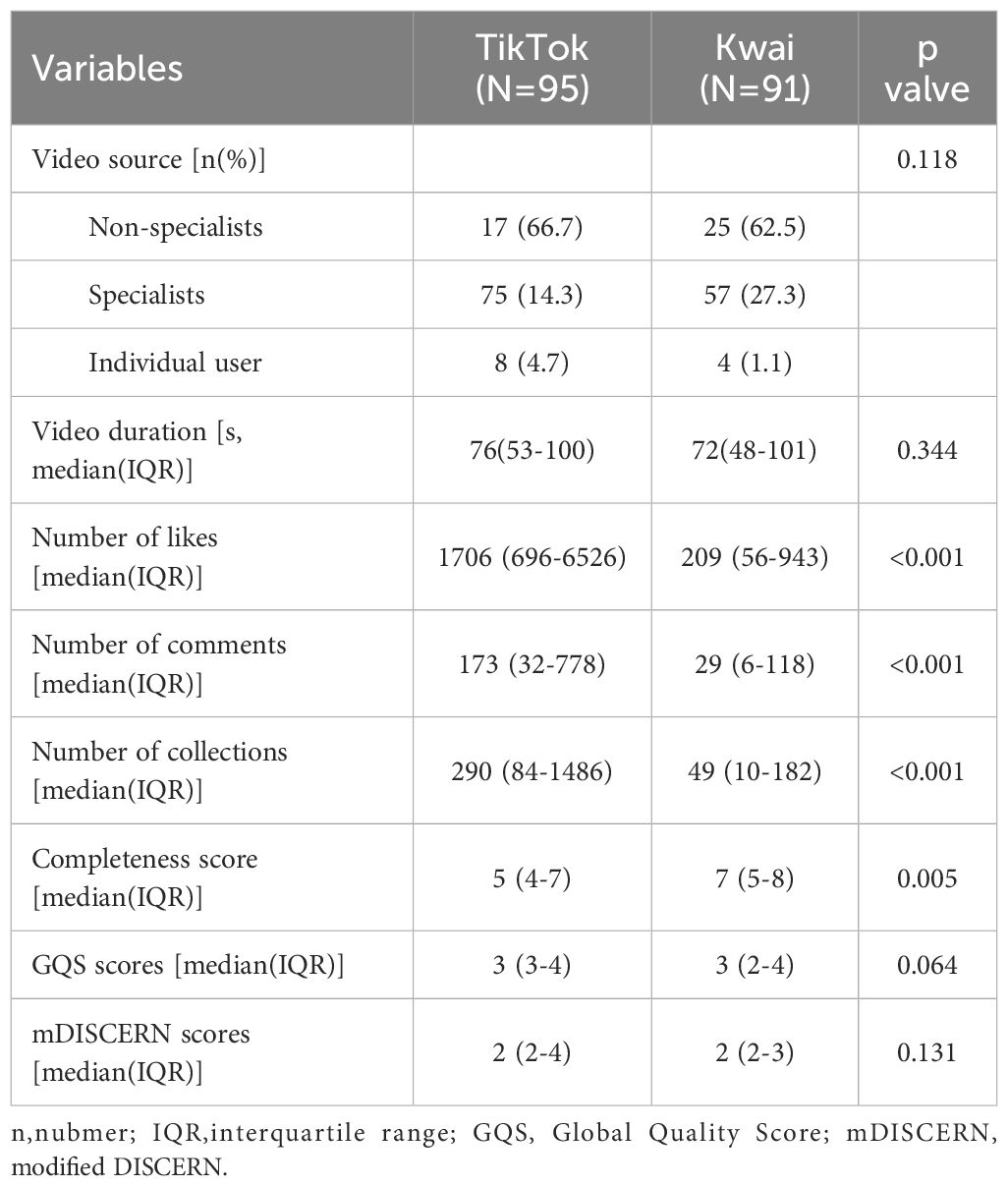
Table 3. Comparison of 186 lung cancer related-short videos in different short-video sharing platforms in China in 2024.

Table 4. Comparison of 186 lung cancer related-short video in different video source in China in 2024.
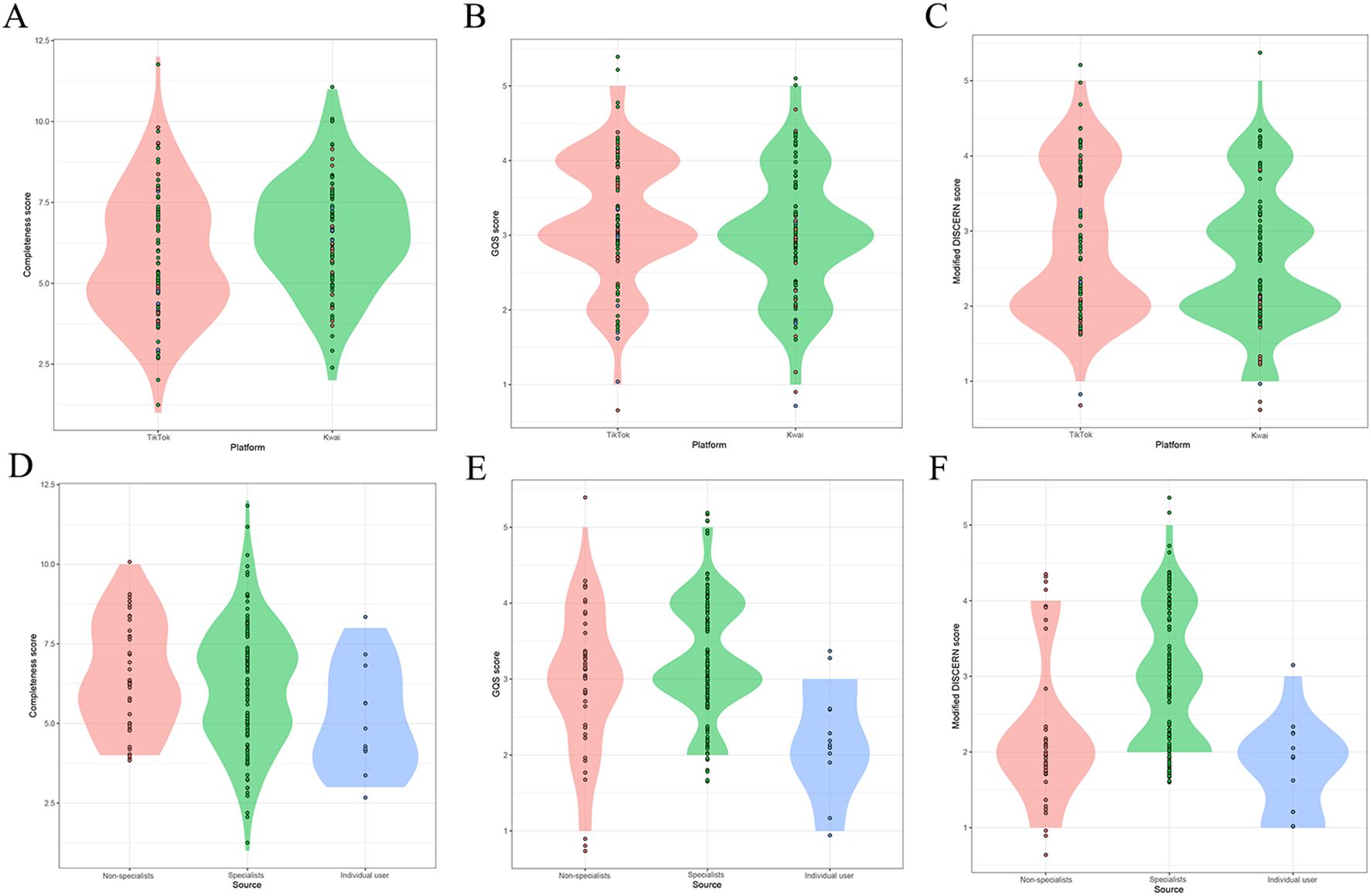
Figure 3. Comparison of video information quality from different sources. (A–C) Comparison of completeness score of different platforms, GQS scores and mDISCERN scores by violin plot. (D–F) Comparison of completeness score, GQS scores and mDISCERN scores by different users of violin plot.
Discussion
The visual social platform has gained popularity and demonstrated its advantages in disseminating health knowledge (15, 16). Video platforms replace traditional text-based information with visually appealing content, facilitating easier processing and retention of information for individuals (12, 26, 27). Moreover, the incorporation of health-related content evokes emotional responses and motivates individuals to engage in proactive health behaviors (28). As a highly prevalent and fatal malignant tumor in China, lung cancer imposes a substantial disease burden on the country’s healthcare resources (5). The mortality rate associated with lung cancer continues to rise, particularly in rural areas characterized by low health literacy levels (29, 30), and short video platforms are the most suitable tools for health communication and education. The assurance of video information quality remains a primary concern for these platforms, given the varying levels of information accuracy and potential dissemination of biased or misleading content.
The information quality of the 186 videos screened by the two platforms in this study was generally unsatisfactory. While most videos provided comprehensive presentations on symptoms of lung cancer, there was a lack of coverage on the epidemiology, etiology, diagnosis, and treatment of lung cancer, particularly regarding complications. Notably, almost half of the videos failed to mention any lung cancer-related complications. One potential explanation is that individuals may excessively focus on the direct respiratory symptoms associated with lung cancer, while overlooking the potential impact of lung cancer on other bodily systems, such as the digestive system, endocrine system, and circulatory system. 40.3% of the videos mentioned the prevention of lung cancer, including screening programs such as CT and bronchoscopy. 38.7% of the videos had a detailed explanation of the treatment of lung cancer, and only 17.2% of the videos did not mention the treatment of lung cancer. However, none of the videos mentioned post-chemotherapy/radiotherapy and post- surgical care, which may need to be mentioned in future popular science videos.
In the process of video analysis, we observed distinct disparities in the characteristics between videos on the TikTok and Kwai platforms. Interestingly, TikTok videos exhibited significantly higher engagement metrics such as likes, shares, and comments compared to those on Kwai platform. Moreover, there was a discernible discrepancy in terms of video completeness favoring Kwai over TikTok. This disparity may be attributed to TikTok’s predominant popularity among younger demographics resulting in a relatively lower emphasis on video quality but higher transmission rates. The comparison of video information from various user sources revealed that more than half of the videos were contributed by experts, indicating a higher reliability in video information compared to non-experts and individual users. These findings align with previous studies conducted on the YouTube platform (31, 32). However, it is worth noting that certain videos exhibit subpar information quality. Consequently, we recommend implementing content screening measures and enhancing the informational integrity of health-related videos on this platform to ensure effective lung cancer prevention and management while reducing its incidence and mortality rates. The correlation analysis revealed that there was no significant association between the quality of the video and the number of likes, favorites, and comments from the audience, which contradicts previous research (33, 34) expectations. However, a positive correlation was observed between the duration of the video and its information quality, suggesting that high-quality lung cancer videos tend to offer detailed and comprehensive content rather than being short-lived or focused on generating quick traffic.
Our study has several limitations. Firstly, our evaluation of the quality of lung cancer video information is restricted to the Chinese platform, thus limiting its generalizability to other languages. Secondly, due to the time-sensitive nature of video content, we solely analyzed the quality of video information within a specific timeframe. In addition, we only evaluated the top 100 videos on both platforms, which may not be a comprehensive reflection of the video quality of the platforms. Lastly, our analysis is confined to the two most prominent video platforms in China, future studies should encompass additional platforms for a comprehensive analysis.
Conclusion
A total of 186 lung cancer videos from both platforms were analyzed in this study. However, the video quality and reliability are suboptimal, and there is a dearth of reports on topics pertaining to lung cancer complications. Nevertheless, videos uploaded by experts elucidating lung cancer exhibited superior quality and comprehensiveness. In the future, it is imperative to further enhance the quality of short video information related to lung cancer and subject it to meticulous expert review for the development of more high-quality content. This will ensure accurate dissemination of knowledge about lung cancer to the platform audience and fortify its prevention and management.
Data availability statement
The original contributions presented in the study are included in the article/Supplementary Material, further inquiries can be directed to the corresponding authors.
Ethics statement
Ethical approval was not required for the studies involving humans because the data of this study are publicly available and no ethical statement is required. The studies were conducted in accordance with the local legislation and institutional requirements. Written informed consent for participation was not required from the participants or the participants’ legal guardians/next of kin in accordance with the national legislation and institutional requirements because The data of this study are publicly available and no ethical statement is required.
Author contributions
XZ: Writing – original draft, Writing – review & editing, Visualization. XY: Data curation, Formal analysis, Writing – review & editing. BS: Data curation, Investigation, Writing – review & editing. YZ: Writing – original draft, Writing – review & editing, Software, Supervision.
Funding
The author(s) declare that no financial support was received for the research, authorship, and/or publication of this article.
Conflict of interest
The authors declare that the research was conducted in the absence of any commercial or financial relationships that could be construed as a potential conflict of interest.
Publisher’s note
All claims expressed in this article are solely those of the authors and do not necessarily represent those of their affiliated organizations, or those of the publisher, the editors and the reviewers. Any product that may be evaluated in this article, or claim that may be made by its manufacturer, is not guaranteed or endorsed by the publisher.
Supplementary material
The Supplementary Material for this article can be found online at: https://www.frontiersin.org/articles/10.3389/fonc.2024.1420976/full#supplementary-material
References
1. Leiter A, Veluswamy RR, Wisnivesky JP. The global burden of lung cancer: current status and future trends. Nat Rev Clin Oncol. (2023) 20:624–39. doi: 10.1038/s41571-023-00798-3
2. Malvezzi M, Santucci C, Boffetta P, Collatuzzo G, Levi F, La Vecchia C, et al. European cancer mortality predictions for the year 2023 with focus on lung cancer. Ann Oncol. (2023) 34:410–9. doi: 10.1016/j.annonc.2023.01.010
3. Qi J, Li M, Wang L, Hu Y, Liu W, Long Z, et al. National and subnational trends in cancer burden in China, 2005-20: an analysis of national mortality surveillance data. Lancet Public Health. (2023) 8:e943–e55. doi: 10.1016/S2468-2667(23)00211-6
4. Li C, Lei S, Ding L, Xu Y, Wu X, Wang H, et al. Global burden and trends of lung cancer incidence and mortality. Chin Med J (Engl). (2023) 136:1583–90. doi: 10.1097/CM9.0000000000002529
5. Sung H, Ferlay J, Siegel RL, Laversanne M, Soerjomataram I, Jemal A, et al. Global cancer statistics 2020: GLOBOCAN estimates of incidence and mortality worldwide for 36 cancers in 185 countries. CA Cancer J Clin. (2021) 71:209–49. doi: 10.3322/caac.21660
6. Lam DC, Liam CK, Andarini S, Park S, Tan DSW, Singh N, et al. Lung cancer screening in Asia: an expert consensus report. J Thorac Oncol. (2023) 18:1303–22. doi: 10.1016/j.jtho.2023.06.014
7. Oncology Society of Chinese Medical A. Chinese Medical Association guideline for clinical diagnosis and treatment of lung cancer (2024 edition). Zhonghua Yi Xue Za Zhi. (2024) 104:3175–213. doi: 10.3760/cma.j.cn112137-20240511-01092
8. Carter-Harris L, Ceppa DP, Hanna N, Rawl SM. Lung cancer screening: what do long-term smokers know and believe? Health Expect. (2017) 20:59–68. doi: 10.1111/hex.12433
9. Jonnalagadda S, Bergamo C, Lin JJ, Lurslurchachai L, Diefenbach M, Smith C, et al. Beliefs and attitudes about lung cancer screening among smokers. Lung Cancer. (2012) 77:526–31. doi: 10.1016/j.lungcan.2012.05.095
10. Welch V, Petkovic J, Pardo Pardo J, Rader T, Tugwell P. Interactive social media interventions to promote health equity: an overview of reviews. Health Promot Chronic Dis Prev Can. (2016) 36:63–75. doi: 10.24095/hpcdp.36.4.01
11. Song S, Xue X, Zhao YC, Li J, Zhu Q, Zhao M. Short-video apps as a health information source for chronic obstructive pulmonary disease: information quality assessment of tikTok videos. J Med Internet Res. (2021) 23:e28318. doi: 10.2196/28318
12. He Z, Wang Z, Song Y, Liu Y, Kang L, Fang X, et al. The reliability and quality of short videos as a source of dietary guidance for inflammatory bowel disease: cross-sectional study. J Med Internet Res. (2023) 25:e41518. doi: 10.2196/41518
13. Yao L, Li Y, Lian Q, Sun J, Zhao S, Wang P. Health information sharing on social media: quality assessment of short videos about chronic kidney disease. BMC Nephrol. (2022) 23:378. doi: 10.1186/s12882-022-03013-0
14. Hu RH, Zhang HB, Yuan B, Zhang KH, Xu JY, Cui XM, et al. Quality and accuracy of gastric cancer related videos in social media videos platforms. BMC Public Health. (2022) 22:2025. doi: 10.1186/s12889-022-14417-w
15. Apperson A, Stellefson M, Paige SR, Chaney BH, Chaney JD, Wang MQ, et al. Facebook groups on chronic obstructive pulmonary disease: social media content analysis. Int J Environ Res Public Health. (2019) 16. doi: 10.3390/ijerph16203789
16. Paige SR, Stellefson M, Chaney BH, Chaney JD, Alber JM, Chappell C, et al. Examining the Relationship between Online Social Capital and eHealth Literacy: Implications for Instagram Use for Chronic Disease Prevention among College Students. Am J Health Educ. (2017) 48:264–77. doi: 10.1080/19325037.2017.1316693
17. Oser SM, Stuckey HL, Parascando JA, McGinley EL, Berg A, Oser TK. Glycated hemoglobin differences among blog-reading adults with type 1 diabetes compared with those who do not read blogs: cross-sectional study. JMIR Diabetes. (2019) 4:e13634. doi: 10.2196/13634
18. Xu QR, Wu PZ, Du JZ, Zhuang WJ, He XT, Ma YY, et al. Online short videos promoting public breast cancer literacy: a pretest-posttest control group trial on efficiency, attitude, and influencing factors. Front Public Health. (2023) 11:1198780. doi: 10.3389/fpubh.2023.1198780
19. Stellefson ML, Shuster JJ, Chaney BH, Paige SR, Alber JM, Chaney JD, et al. Web-based Health Information Seeking and eHealth Literacy among Patients Living with Chronic Obstructive Pulmonary Disease (COPD). Health Commun. (2018) 33:1410–24. doi: 10.1080/10410236.2017.1353868
20. Yeung A, Ng E, Abi-Jaoude E. TikTok and attention-deficit/hyperactivity disorder: A cross-sectional study of social media content quality. Can J Psychiatry. (2022) 67:899–906. doi: 10.1177/07067437221082854
21. Yeung AWK, Tosevska A, Klager E, Eibensteiner F, Tsagkaris C, Parvanov ED, et al. Medical and health-related misinformation on social media: bibliometric study of the scientific literature. J Med Internet Res. (2022) 24:e28152. doi: 10.2196/28152
22. Vandormael A, Adam M, Greuel M, Gates J, Favaretti C, Hachaturyan V, et al. The effect of a wordless, animated, social media video intervention on COVID-19 prevention: online randomized controlled trial. JMIR Public Health Surveill. (2021) 7:e29060. doi: 10.2196/29060
23. Mueller SM, Jungo P, Cajacob L, Schwegler S, Itin P, Brandt O. The absence of evidence is evidence of non-sense: cross-sectional study on the quality of psoriasis-related videos on youTube and their reception by health seekers. J Med Internet Res. (2019) 21:e11935. doi: 10.2196/11935
24. Mukewar S, Mani P, Wu X, Lopez R, Shen B. YouTube and inflammatory bowel disease. J Crohns Colitis. (2013) 7:392–402. doi: 10.1016/j.crohns.2012.07.011
25. Langille M, Bernard A, Rodgers C, Hughes S, Leddin D, van Zanten SV. Systematic review of the quality of patient information on the internet regarding inflammatory bowel disease treatments. Clin Gastroenterol Hepatol. (2010) 8:322–8. doi: 10.1016/j.cgh.2009.12.024
26. Goodyear VA, Wood G, Skinner B, Thompson JL. The effect of social media interventions on physical activity and dietary behaviours in young people and adults: a systematic review. Int J Behav Nutr Phys Act. (2021) 18:72. doi: 10.1186/s12966-021-01138-3
27. Adam M, Chase RP, McMahon SA, Kuhnert KL, Johnston J, Ward V, et al. Design preferences for global scale: a mixed-methods study of "glocalization" of an animated, video-based health communication intervention. BMC Public Health. (2021) 21:1223. doi: 10.1186/s12889-021-11043-w
28. Feng B, Malloch YZ, Kravitz RL, Verba S, Iosif AM, Slavik G, et al. Assessing the effectiveness of a narrative-based patient education video for promoting opioid tapering. Patient Educ Couns. (2021) 104:329–36. doi: 10.1016/j.pec.2020.08.019
29. Jiang D, Zhang L, Liu W, Ding Y, Yin J, Ren R, et al. Trends in cancer mortality in China from 2004 to 2018: A nationwide longitudinal study. Cancer Commun (Lond). (2021) 41:1024–36. doi: 10.1002/cac2.12195
30. Zhang M, Yang L, Wang L, Jiang Y, Huang Z, Zhao Z, et al. Trends in smoking prevalence in urban and rural China, 2007 to 2018: Findings from 5 consecutive nationally representative cross-sectional surveys. PloS Med. (2022) 19:e1004064. doi: 10.1371/journal.pmed.1004064
31. Stellefson M, Chaney B, Ochipa K, Chaney D, Haider Z, Hanik B, et al. YouTube as a source of chronic obstructive pulmonary disease patient education: a social media content analysis. Chron Respir Dis. (2014) 11:61–71. doi: 10.1177/1479972314525058
32. Goobie GC, Guler SA, Johannson KA, Fisher JH, Ryerson CJ. YouTube videos as a source of misinformation on idiopathic pulmonary fibrosis. Ann Am Thorac Soc. (2019) 16:572–9. doi: 10.1513/AnnalsATS.201809-644OC
33. Sun F, Zheng S, Wu J. Quality of information in gallstone disease videos on tikTok: cross-sectional study. J Med Internet Res. (2023) 25:e39162. doi: 10.2196/39162
Keywords: lung cancer, short video, health information, health education, medical knowledge
Citation: Zhao X, Yao X, Sui B and Zhou Y (2024) Current status of short video as a source of information on lung cancer: a cross-sectional content analysis study. Front. Oncol. 14:1420976. doi: 10.3389/fonc.2024.1420976
Received: 21 April 2024; Accepted: 05 November 2024;
Published: 22 November 2024.
Edited by:
Christopher McKinley, Montclair State University, United StatesCopyright © 2024 Zhao, Yao, Sui and Zhou. This is an open-access article distributed under the terms of the Creative Commons Attribution License (CC BY). The use, distribution or reproduction in other forums is permitted, provided the original author(s) and the copyright owner(s) are credited and that the original publication in this journal is cited, in accordance with accepted academic practice. No use, distribution or reproduction is permitted which does not comply with these terms.
*Correspondence: Yutao Zhou, NDY2NTg3MDBAcXEuY29t
 Xinyu Zhao
Xinyu Zhao Yutao Zhou
Yutao Zhou